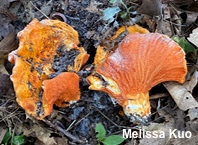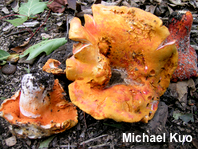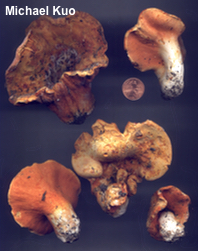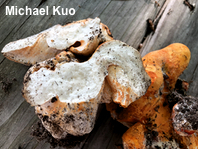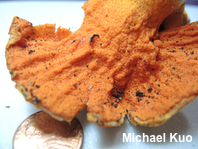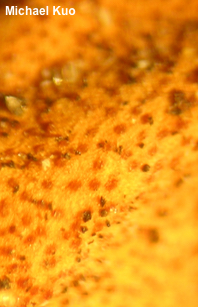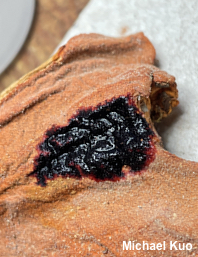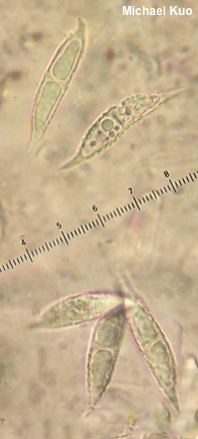| Major Groups > Oddballs & Misfits / Mycotrophs > Hypomyces > Hypomyces lactifluorum |

|
[ Ascomycota > Sordariomycetes > Hypocreales > Hypocreaceae > Hypomyces . . . ] Hypomyces lactifluorum by Michael Kuo, 1 September 2023 Sometimes called the "lobster mushroom," Hypomyces lactifluorum is actually a fungus that has parasitized another mushroom–usually a white Russula or Lactarius. There's really no mistaking it: the fungus creates a beautiful, bright orange covering that spreads over the mushroom, the surface of which is rather hard, and dotted with tiny pimples. Eventually, the fungus even begins to transform the shape of the host mushroom, twisting it into odd contortions. A 2018 study (Laperriere et al.) determined that Hypomyces lactifluorum gradually conquers the host mushroom; during development of the Hypomyces, the host's DNA decreases—first at the margins, then in the cap, and finally in the stem; when the "lobster mushroom" is a contorted and orange, very little of the host mushroom's DNA is still present, even though the interior flesh appears identical and unchanged (see the fourth illustration). Chemical testing is probably not required for accurate identification of Hypomyces lactifluorum, but can be fun, since a drop of KOH on the orange surface reliably produces a quick color change to dark purple, even in dried specimens that have sat in a herbarium for decades. Description: Ecology: Parasitic on species of Russula, Lactarius, and Lactifluus—especially Russula brevipes, Lactarius deceptivus, and other members of the Lactarius piperatus group; summer and fall, or over winter in warm climates; originally described from North Carolina (von Schweinitz 1822); widely distributed in North America throughout Canada, the United States, and Mexico. The illustrated and described collections are from Georgia and Michigan. Fruiting Body: A hard, pimply, orange coating that attacks the host rapidly and soon covers all surfaces, disfiguring the mushroom; with old age the orange often darkens to purplish red. Perithecia: Reddish brown to nearly black; usually visible to the naked eye. Chemical Reactions: KOH on surface instantly dark purple, even in dried specimens. Microscopic Features: Spores 30–40 x 5–7 µm; fusiform; verrucose; apiculi about 5 µm long, narrowing to a point; hyaline to ochraceous in water and KOH; septate once. Asci 200–275 x 6–10 µml cylindric; 8-spored. Subicular hyphae 3–10 µm wide, septate, smooth, sometimes gelatinized, purple-walled in KOH. REFERENCES: (L. D. von Schweinitz, 1822) L. R. Tulasne & C. Tulasne, 1860. (Smith, 1975; Weber, & Smith, 1985; Arora, 1986; States, 1990; Phillips, 1991/2005; Schalkwijk-Barendsen, 1991; Lincoff, 1992; Metzler & Metzler, 1992; Horn, Kay & Abel, 1993; Rogerson & Samuels, 1994; Barron, 1999; Roody, 2003; McNeil, 2006; Miller & Miller, 2006; Kuo, 2007; Trudell & Ammirati, 2009; Beug et al., 2014; Kuo & Methven, 2014; Desjardin, Wood & Stevens, 2015; Siegel & Schwarz, 2016; Woehrel & Light, 2017; Baroni, 2017; Elliott & Stephenson, 2018; Laperriere et al., 2018; McKnight et al., 2021.) Herb. Kuo 10170903, 09111003, 08122001. This website contains no information about the edibility or toxicity of mushrooms. |
© MushroomExpert.Com |
|
Cite this page as: Kuo, M. (2023, September). Hypomyces lactifluorum. Retrieved from the MushroomExpert.Com Web site: http://www.mushroomexpert.com/hypomyces_lactifluorum.html |
